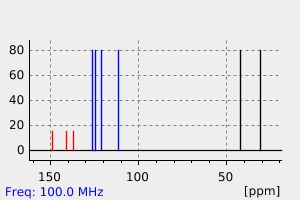1-甲基-2-(甲磺酰基)苯并咪唑 | 61078-14-6
中文名称
1-甲基-2-(甲磺酰基)苯并咪唑
中文别名
——
英文名称
1-methyl-2-(methylsulfonyl)benzimidazole
英文别名
1-methyl-2-(methylsulfonyl)-1H-benzo[d]imidazole;MSBI;1H-benzimidazole, 1-methyl-2-(methylsulfonyl)-;1-methyl-2-methylsulfonylbenzimidazole
CAS
61078-14-6
化学式
C9H10N2O2S
mdl
——
分子量
210.257
InChiKey
VDZVTXFWEKBHBV-UHFFFAOYSA-N
BEILSTEIN
——
EINECS
——
-
物化性质
-
计算性质
-
ADMET
-
安全信息
-
SDS
-
制备方法与用途
-
上下游信息
-
文献信息
-
表征谱图
-
同类化合物
-
相关功能分类
-
相关结构分类
物化性质
-
熔点:132.0 to 136.0 °C
-
沸点:394.5±25.0 °C(Predicted)
-
密度:1.36±0.1 g/cm3(Predicted)
-
最大波长(λmax):278nm(EtOH)(lit.)
计算性质
-
辛醇/水分配系数(LogP):0.9
-
重原子数:14
-
可旋转键数:1
-
环数:2.0
-
sp3杂化的碳原子比例:0.22
-
拓扑面积:60.3
-
氢给体数:0
-
氢受体数:3
安全信息
-
储存条件:室温
SDS
上下游信息
-
上游原料
中文名称 英文名称 CAS号 化学式 分子量 嘧啶-4-甲醛 1-methyl-2-(methylthio)-1H-benzimidazole 4344-61-0 C9H10N2S 178.258 2-(甲基磺酰基)-(9ci)-1H-苯并咪唑 2-(methylsulfonyl)-1H-benzo[d]imidazole 57159-81-6 C8H8N2O2S 196.23
反应信息
-
作为反应物:描述:参考文献:名称:Bednjagina; Postowskii, Chemija, 1959, p. 333,334摘要:DOI:
-
作为产物:描述:2-(甲基硫代)苯并咪唑 在 hexaammonium heptamolybdate tetrahydrate 、 双氧水 、 sodium hydride 作用下, 以 乙醇 、 水 、 N,N-二甲基甲酰胺 、 mineral oil 为溶剂, 反应 43.0h, 生成 1-甲基-2-(甲磺酰基)苯并咪唑参考文献:名称:曙红Y促进芳香砜的无金属氨基甲基化摘要:报道了杂环与有机染料的光催化氨甲基化。通过氨基甲基自由基形成的 C-C 键可以一步获得一系列功能化的杂环,而无需过渡金属。DOI:10.1002/chem.202102124
-
作为试剂:描述:(2R,3S,5S)-3-(benzyloxy)-5-[6-(benzyloxy)-2-[(triphenylmethyl)amino]-9H-purin-9-yl]-2-[(benzyloxy)methyl]cyclopentan-1-one 在 1-甲基-2-(甲磺酰基)苯并咪唑 、 potassium tert-butylate 作用下, 以 N,N-二甲基甲酰胺 为溶剂, 反应 2.0h, 以90%的产率得到(1S,3R,4S)-6-(benzyloxy)-9-[4-(benzyloxy)-3-[(benzyloxy)methyl]-2-methylidenecyclopentyl]-N-(triphenylmethyl)-6,9-dihydro-1H-purin-2-amine参考文献:名称:CN106588931摘要:公开号:
文献信息
-
Radical Anion Promoted Chemoselective Cleavage of Csp<sup>2</sup>–S Bond Enables Formal Cross-Coupling of Aryl Methyl Sulfones with Alcohols作者:Jixiang Bai、Tianxin Wang、Botao Dai、Qingchao Liu、Peiyuan Yu、Tiezheng JiaDOI:10.1021/acs.orglett.1c01926日期:2021.8.6revealed as the major pathway. DFT calculations indicate that the formation of a radical anion via nucleophilic addition of alkoxide to the aryl radical is the key step in determining the observed chemoselectivity.开发了一种新的芳基甲基砜和醇的正式交叉偶联,通过 S RN 1 途径提供烷基芳基醚。使用这种方法作为关键步骤,有效地制备了两种市售的抗结核药物。二甲基阴离子引发的自由基链过程被揭示为主要途径。DFT 计算表明,通过醇盐与芳基的亲核加成形成自由基阴离子是确定观察到的化学选择性的关键步骤。
-
FUSED HETEROCYCLIC COMPOUNDS申请人:TANIGUCHI Takahiko公开号:US20110319394A1公开(公告)日:2011-12-29The present invention provides a compound which has the effect of PDE inhibition, and which is useful as an agent for preventing or treating schizophrenia. The compound is represented by the formula (I): wherein the symbols are defined in the specification.本发明提供了一种具有磷酸二酯酶抑制作用的化合物,可用作预防或治疗精神分裂症的药剂。该化合物由以下式表示(I): 其中符号在规范中定义。
-
Ceramide-Templated Macrolactams: Total Synthesis and Biological Evaluation of Macrocyclic α-Galactosylceramide Analogues and their Aglycons作者:Jonas Janssens、Johan Van der Eycken、Serge Van CalenberghDOI:10.1002/ejoc.201801839日期:2019.3.31We present the total synthesis of macrocyclic analogues of the immunomodulating glycolipid alpha-GalCer (KRN7000), along with the corresponding macrocyclic aglycons. Their structures are inspired by the conformation of alpha-GalCer when bound to the antigen presenting glycoprotein CD1d. The applied synthesis plan, involving either ring-closing metathesis or ruthenium-catalyzed azide-alkyne cycloaddition
-
Practical Methylenation Reaction for Aldehydes and Ketones Using New Julia-Type Reagents作者:Kaori Ando、Takahisa Kobayashi、Nariaki UchidaDOI:10.1021/acs.orglett.5b01049日期:2015.5.15A new Julia-type methylenation reagent, 1-methyl-2-(methylsulfonyl)benzimidazole (1e), reacts with a variety of aldehydes and ketones in the presence of either NaHMDS (−55 °C to rt) or t-BuOK (rt, 1 h) in DMF to give the corresponding terminal alkenes in high yields. The byproducts are easily removed, and the reaction conditions are mild and practical.
-
Methylenation for Aldehydes and Ketones Using 1-Methylbenzimidazol-2-yl Methyl Sulfone作者:Kaori Ando、Mai Oguchi、Takahisa Kobayashi、Haruka Asano、Nariaki UchidaDOI:10.1021/acs.joc.0c01227日期:2020.8.7The methylenation reagent 1-methylbenzimidazol-2-yl methyl sulfone 2 reacts with various aldehydes and ketones in the presence of t-BuOK (room temperature, 1 h) in dimethylformamide to give the corresponding terminal alkenes generally in high yields. For sensitive substrates, the reaction is better carried out at low temperature using sodium hexamethyldisilazide in 1,2-dimethoxyethane. The byproduct
表征谱图
-
氢谱1HNMR
-
质谱MS
-
碳谱13CNMR
-
红外IR
-
拉曼Raman
-
峰位数据
-
峰位匹配
-
表征信息
同类化合物
(S)-(-)-2-(α-(叔丁基)甲胺)-1H-苯并咪唑
(S)-(-)-2-(α-甲基甲胺)-1H-苯并咪唑
麦穗宁
马哌斯汀
颜料橙62
顺式-5,6-二氢-4,5-二甲基-4H-咪唑并[1,5,4-De]喹喔啉
韦罗肟
青菌灵
雷贝拉唑钠
雷贝拉唑硫醚N-氧化物
雷贝拉唑砜 N-氧化物
雷贝拉唑砜
雷贝拉唑杂质2
雷贝拉唑 N-氧化物
雷贝拉唑
阿苯达唑砜
阿苯达唑杂质L
阿苯达唑杂质J(EP)
阿苯达唑杂质J
阿苯达唑杂质F
阿苯达唑杂质14
阿苯达唑杂质13
阿苯达唑亚砜
阿苯达唑
阿苯哒唑砜-D3
阿苯哒唑-D3
阿地本旦
阿司咪唑-d3
阿司咪唑
钠4-[5-氯-2-[(E,3E)-3-[6-氯-1-乙基-3-(4-磺酸丁基)-5-(三氟甲基)苯并咪唑-2-亚基]丙-1-烯基]-3-乙基-6-(三氟甲基)苯并咪唑-1-鎓-1-基]丁烷-1-磺酸盐
邻甲磺酰胺基苯乙酸
那地特罗
达比加群酯杂质M
达比加群酯杂质4
达比加群酯杂质1
达比加群酯杂质
达比加群酯N-氧化物
达比加群酯
达比加群脂杂质10
达比加群甲酯杂质
达比加群杂质J
达比加群杂质J
达比加群杂质F
达比加群杂质E
达比加群杂质D
达比加群杂质C5
达比加群杂质38
达比加群杂质13
达比加群杂质10(DABRC-10)
达比加群杂质10







